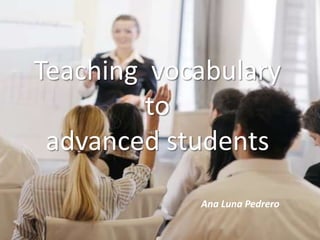
Teaching vocabulary to advanced students
- 1. Teaching vocabulary to advanced students Ana Luna Pedrero
- 2. Broaden their vocabulary Take in account others Advanced Understand factors (oral, written,use of the language) students need the meaning to of words Use the words appropriately
- 3. Teaching vocabulary -Boundaries between conceptual meaning -Polysemy It is important to -Homonymy -Homophyny take into account -Synonymy aspects of lexis -Affective meaning -Style, register, dialect when we teach -Traslation vocabulary -Chunks of language -Pronuntiation
- 4. Memory and storage systems Understanding how our memory works might help us create more effective ways to teach vocabulary Short – term memory Long –term memory - Retention is not effective if the - It can hold any number of amount of chunks exceeds information seven
- 5. Applying images and sounds : ussing imagery , semantic mapping , using keywords Creating Employing mental action : linkages : Exists important physical grouping memory strategies response or , associating sensation , placing new to aid learning , using word into mechanical context techniques Reviewing well , in a structured way
- 6. Knowledge of word formation Main ways to Guided deal with Using dictionaries discovery meaning Contextual guesswork
- 7. Using language Teachers have Their awareness to promote Based on of students needs motivation and preferences
- 8. The lexical approach ( by Lewis ) -The importance of vocabulary as being basic to communication -- If learners do not recognise the meaning of keywords they will be unable to participate in the conversation -- grammar is equally important in teaching as vocabulary . --Make students aware of chunks .
- 9. Rationale of the lesson Students have to notice collocations and deal with meaning .- Group work helps to exchange knowledge. -Make students use the language in realist context .
